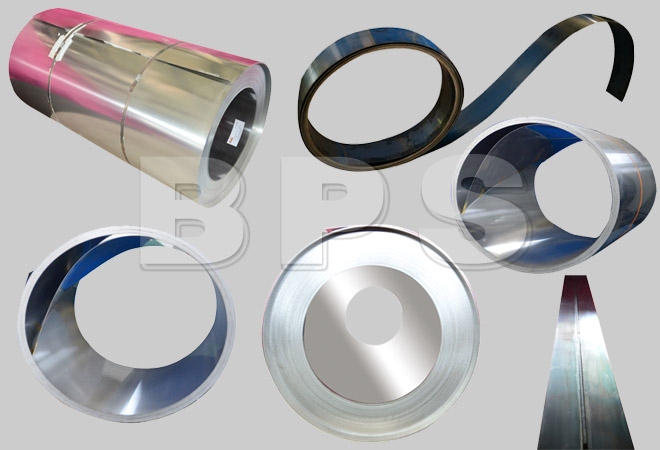 |
General description
BPS-SB-1100C is a martensitic carbon steel belt used mainly for bake oven process systems..
It offers the following advantages:
· Excellent metallurgical properties
· Close tolerances
· Smooth surface, extra accuracy on flatness and straightness
· Good blanking properties
· Good hardening properties
· Good grinding and honing properties, facilitating the manufacture of high quality edges
· Consistent material properties from coil to coil, from delivery to delivery
Chemical composition (nominal) %
| C |
Si |
Mn |
P max |
S max |
Cr |
| 0.68 |
0.4 |
0.7 |
0.025 |
0.010 |
13 | Physical properties
The physical properties of a steel are related to a number of factors, including alloying elements, heat treatment and manufacturing route, but the data presented below can generally be used for rough calculations.
| Density |
|
| g/cm3 |
7.7 |
| lb/inch3 |
0.28 | Forms of supply
is supplied as cold rolled in coils. The tensile strength is 1070±100 MPa (155±14.5 ksi).Coils are carefully packed, with various packing materials being used according to customer requirements, destination and method of transport.
Coil sizes
Razor blade steel belt is wound into pancake coils on plastic cores with an inner diameter of 280 mm (11,0 inches). The coils can be supplied in weights between 1 and 5 kg/mm steel belt width, which means an outer diameter from about 500 to 1000 mm (20-40 inches)
Dimensions and tolerances
| Steel belt thickness |
Thickness tolerance |
| (mm) |
(inch) |
(mm ±) |
(inch ±) |
| 0,076 |
0,0030 |
0,005 |
0,00020 |
| 0,099 |
0,0039 |
0,005 |
0,00020 | Width
Widths range between 5 and 1200 mm (0,2-47,2 inches).
Other dimensions and forms of supply can be supplied to meet specific requirements.
Microstructure
Unhardened condition ('as delivered')
In the 'as delivered', unhardened condition, BPS-SB-1100C consists of finely dispersed carbides in a ferritic matrix, see figure 1. The carbides are of type M23C6, where M stands for iron and chromium. This type of carbide is easily dissolved during the heat treatment, which is important for good hardening results. The fine dispersion of the carbides also helps to speed up their dissolution, allowing lower furnace temperatures and higher speeds during hardening.
The ferritic matrix has low contents of carbon and chromium because these elements are bound in carbides. Since the chromium content in the matrix determines the corrosion resistance of the steel, the material has limited resistance to corrosion in the 'as delivered' condition.
Because of very careful control in the manufacture of the steel, large carbides - known as primary carbides - can be avoided, and the amount of non-metallic inclusions can be kept to a minimum. This contributes significantly to the quality of the razor blade edge. Careful process control also ensures that the chemical composition can be kept within very close limits, which results in consistent steel properties.
Figure 1. BPS-SB-1100C , unhardened.
Hardened and tempered condition
After hardening and tempering, BPS-SB-1100C consists of a martensitic matrix with undissolved carbides and some retained austenite, as shown in figure 2. In this condition the steel has good corrosion resistance.
Figure 2. BPS-SB-1100C hardened and tempered.
Heat treatment
The recommended heat treatment for BPS-SB-1100C follows the temperature cycle illustrated in figure 3.
During heating [1], or austenitising, the ferrite is transformed into austenite and the carbides are partly dissolved. Because of the carbide dissolution, the contents of carbon and chromium in the matrix increase. The subsequent quenching to room temperature [2] will transform most of the austenite into martensitc. |
|


